vichie81/iStock/GettyImages
The cooking process for pork ribs is the same whether you have baby back ribs, spareribs or country-style ribs. Back ribs are the smallest and definitely finger-food, and spareribs are larger and quite flavorful. Country-style ribs are meatier than the others, so they take the longest to cook. While cooking ribs may seem daunting to first-timers, it's not particularly difficult, even if it's a little more involved than tossing something in a pan. They key to producing tender, juicy ribs from a relatively boney, tough pork cut is steaming the slab in the oven before grilling.
Pat a dry rub onto the entire slab of ribs. If you don't have a store-bought meat rub, make your own with items on your spice rack. Equal parts paprika and dry mustard make a standard base. Add salt and pepper to taste, along with seasonings like cayenne or another favorite chili pepper powder, celery salt, onion powder, garlic powder, dried thyme, dried rosemary and some brown sugar for sweetness.
Place the pork slab on a baking tray with raised sides. Cover the ribs and tray tightly with aluminum foil. Refrigerate the ribs for one hour to one day, but preferably on the longer end of this spectrum for maximum flavor.
Preheat your oven to 350 degrees Fahrenheit for at least 20 minutes. In the last few minutes, bring about 2 cups of water or broth to a boil in a small saucepan over high heat.
Set the ribs out on the counter. Pull open the foil in one corner and pour the boiling water onto the tray. Avoid pouring it directly over the slab, or you'll wash off the dry rub. Add as much water as you can without it sloshing over the sides of the tray; then reseal the foil tightly.
Put the ribs in the middle of the oven, where they steam in their own juices and the evaporating water or broth, since they're covered. Cook baby back ribs for about 2 hours, spareribs for about 3 hours or country-style ribs for about 3 1/2 hours, until the pork is soft and tender.
Set the ribs on the counter to cool to room temperature. Or, if you're not grilling them soon -- they can be held for up to three days from this point -- wrap them in foil and refrigerate. Carefully pour the juices left in the bottom of the baking tray into a bowl if you're making your own barbecue sauce.
Grease the rack of your grill with nonstick spray or cooking oil and preheat it to medium. While it heats, coat the whole slab of ribs with barbecue sauce. Use a favorite bottled product or make your own, starting with either a mix of tomato paste and puree or ketchup. Stir in the saved tray drippings, a bit of Worcestershire sauce and a small splash of apple cider vinegar. Season it with any of the ingredients you used for your dry rub, to taste.
Place the pork ribs on the grill, bones down. Cook it for about 10 minutes total, just until the exterior becomes crispy. Turn the slab over about every 2 minutes, brushing it again with more barbecue sauce.
Place the ribs on a serving platter or large cutting board. Use a large, sharp knife to slice the pork between the bones to divide the slab into individual pieces.
Related Articles
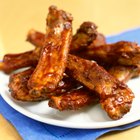
How to Bake Spare Ribs Before BBQing
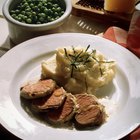
How to Cook Marinated Pork Loin From a ...
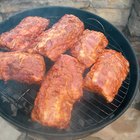
How to Smoke Ribs With a Gas Smoker
How to Barbecue Prime Rib Bones

How to Cook Turkey Legs on the Grill

How to Make Tender Marinated BBQ Pork ...
Easy Cooking for Pork Spareribs

Should You Bake Barbecue Ribs Uncovered ...
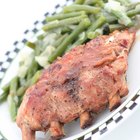
How to BBQ Ribs on a Smoker
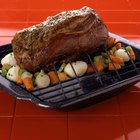
How to Cook a Whole Sirloin Tip Beef ...

How to Cook BBQ Pork Ribs Quickly
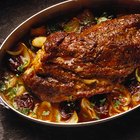
How to Use a Roaster for Pork

How to Barbecue Ribs With a Gas Grill

How to Cook Pork Shoulder Western Ribs ...
How to Smoke Baby Back Ribs

How to Quickly Cook Fork-Tender Ribs

How to Make a Juicy Pork Tenderloin
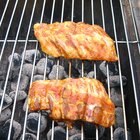
How Do I Cook Spare Ribs in an Electric ...

How to Cook Shredded Pork Roast in a ...
How to Brine Pork Ribs for a BBQ
References
Writer Bio
Eric Mohrman is a food and drink, travel, and lifestyle writer living in Orlando, Florida. He has professional experience to complement his love of cooking and eating, having worked for 10 years both front- and back-of-house in casual and fine dining restaurants. He has written print and web pieces on food and drink topics for Visit Florida, Orlando Style Magazine, CrushBrew Magazine, Agent Magazine, Dollar Stretcher Magazine, The 863 Magazine and other publications.